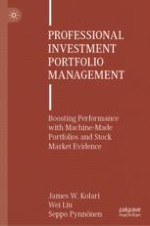In this chapter we demonstrate how to use the ZCAPM asset pricing model to build high-performing long only efficient portfolios. We begin by showing the results for zeta risk sorted portfolios. Recall that in Chapters
8 and
9 we used zeta risk sorted portfolios to form long-short zeta risk portfolios that were added to the global minimum variance portfolio
G to build net long portfolios with both short and long positions. Additionally, we report the results of beta risk sorted portfolios using the empirical ZCAPM. In general, the empirical asset pricing literature has documented many times that there is no relation between beta risk and average stock returns. However, previous literature employs the CAPM market model to estimate beta wherein the CRSP market index or S&P 500 market index are normally used to proxy the market portfolio. Fama and French (
Journal of Finance 47: 427–465, 1992;
Journal of Financial Economics 33: 3–56, 1993;
Journal of Finance 50: 131–156, 1995;
Journal of Finance 51: 1947–1958, 1996) have proven that the CAPM fails using this renowned empirical model. However, as already mentioned in earlier chapters, beta risk in the empirical ZCAPM is different as it is estimated by using the average market return, not a proxy for the market portfolio. As discussed there, a good proxy for the average market return is the
G portfolio.
G has no zeta risk and therefore is a good portfolio to measure beta risk related to average market returns. Our empirical results based on U.S. stock returns are extraordinary. Zeta risk portfolios
trace out the shape of a theoretical Markowitz (
Journal of Finance 7: 77–91, 1952;
Portfolio selection: Efficient diversification of investments. Wiley, New York, NY, 1959) mean-variance investment parabola
, which we refer to as the
empirical parabola. The
G portfolio is located at the leftmost minimum variance location in risk/return space. The CRSP market index lies in the interior of the empirical parabola
in the vicinity of the axis of symmetry as predicted by ZCAPM theory. Thus, the CRSP index
is far from efficient and represents a very poor proxy for the market portfolio. In this respect, Roll (
Journal of Financial Economics 4: 129–176, 1977) has asserted that, without a good proxy for the market portfolio
, the CAPM cannot be tested. We infer that tests by Fama and French and others that have used the CRSP index
to proxy the efficient market portfolio to conclude the CAPM is dead are misleading. Interestingly, with the exception of very high idiosyncratic risk
stocks (i.e., high residual errors
or high standard deviations of returns), our out-of-sample results for beta risk portfolios estimated via the empirical ZCAPM and portfolio
G yield a positive relation with average stock returns. Also, a number of our beta risk portfolios outperform the CRSP market index by substantial amounts. Since the CRSP index and S&P 500 index are very highly correlated and have similar average return performance over time, these findings are notable. Our beta risk results stand in stark contrast to the vast research on the failure of CRSP-based CAPM beta risk. Given the fact that
G-based ZCAPM zeta risk as well as beta risk are related to average stock returns, our zeta and beta sorted portfolios should be of keen interest to the professional investment community. Surely stock market investors could benefit from these portfolios by outperforming general market indexes that are so popular among passive index investors. Moreover, zeta and beta risk levels can be controlled to generate portfolio returns coincident with the risk preferences of investors. In this way, professional managers can customize portfolios to meet the risk/return needs of different investors. The next section provides a review of our empirical methods. The subsequently section reports and discusses the empirical results for long only stock returns. The last section summarizes the chapter.
